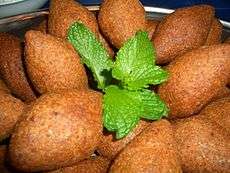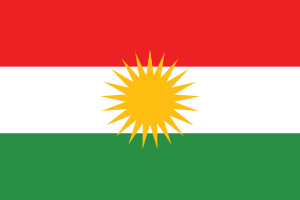Kurdish cuisine
| Part of a series on Kurdish history and Kurdish culture |
 |
|


Kurdish cuisine (Kurdish: چێشتی کوردی Chesht-i Kurdi) consists of a wide variety of foods prepared by the Kurdish people.
Culinary customs
The Kurdish diet includes a wide variety of fruits and vegetables. Lamb and chicken are the primary meats. Breakfast is typically flat bread, cheese, honey, sheep or cow yogurt, and a glass of black tea. For lunch, lamb and vegetables are simmered in a tomato sauce to make a stew usually served with rice and savory dishes are usually served with rice or flat bread (Naan). Kurdistan has a climate and soil suited to grapes, pomegranates, figs, and walnuts. Kurdish honey has a clear light taste and is often sold with the honeycomb. Kurdistan also produces dairy products from sheep and cow milk. Kurds make many types of kofta and kubba, dumplings filled with meat.
Kurdish cuisine makes abundant use of fresh herbs.[1]
Sweetened black tea is a very common drink, along with bitter strong coffee. Another favourite Kurdish drink is "mastow" (sorani) or "Ava Mast", which is yogurt and salt mixed with water (Doogh).[2]
Staples of Kurdish cuisine are berbesel, biryani, dokliw, kellane, kullerenaske, kutilk, parêv tobouli, kuki (meat or vegetable pies), birinç (white rice alone or with meat or vegetables and herbs), and a variety of salads, pastries, and drinks specific to different parts of Kurdistan. Other popular dishes are makluba, kofta, shifta, shilah/maraga, spinach with eggs, wheat & lentil soup, beet & meat soup, sweet turnip, cardamon cookies, burgul pilaf, melemen, mehîr, ûr û rûvî, yaprakh, chichma this dish is common in Erbil (Hewlêr), tefti, niskene and nane niskan.[3]
Sawarr, a traditional dish among Kurdish farmers, is made of wheat grain that is boiled, sun dried and pounded in a mortar (curn) to get rid of the husk. The wheat is then crushed in a mill (destarr). The resulting grain food can be boiled and served.[4]
Tapsi is a dish of aubergines, green peppers, courgettes and potatoes in a slightly spicy tomato sauce. Tashreeb consists of layers of naan in a sauce of green pepper, tomato, onions and chillies.[5] A typical Kurdish breakfast consists of cheese, butter, olives, eggs, tomatoes, cucumbers, green peppers, reçel (jam/marmalade; a preserve of whole fruits) and honey usually consumed on top of kaymak. Sausage, baked goods and even soups can be taken as a morning meal in Kurdistan. Perhaps more so than traditional breads such as pide, a crusty white loaf is widely consumed. A common Kurdish speciality for breakfast is called menemen, which is prepared with roasted tomatoes, peppers, olive oil and eggs. Invariably, black tea is served at breakfast.
Holiday celebrations
During the festival of Nawroz, Kurds enjoy picnics in the countryside, often taking a large pot of Dolma, Dolma is a dish of freshly picked vine leaves stuffed with rice, meat, herbs and garlic.
Kurdish people also enjoy Eid food such as Chicken and Dolma.
Melmerchouk
-
 Kurdistan portal
Kurdistan portal -
 Food portal
Food portal
References
- ↑ "Kurdistan's cuisine". Krg.org. 2010-06-27. Retrieved 2012-05-21.
- ↑ "Kurdistan's cuisine". Krg.org. 2010-06-27. Retrieved 2012-05-21.
- ↑ "Middle East". Web.archive.org. 2008-02-01. Archived from the original on February 1, 2008. Retrieved 2012-05-21.
- ↑ "The food that launched civilization". Google.com. 2012-05-05. Retrieved 2012-05-21.
- ↑ "Iraqi Kurdish, Life Style". London: Guardian.co.uk. 2007-04-07. Retrieved 2012-05-21.
External sources
| Wikimedia Commons has media related to Kurdish cuisine. |
